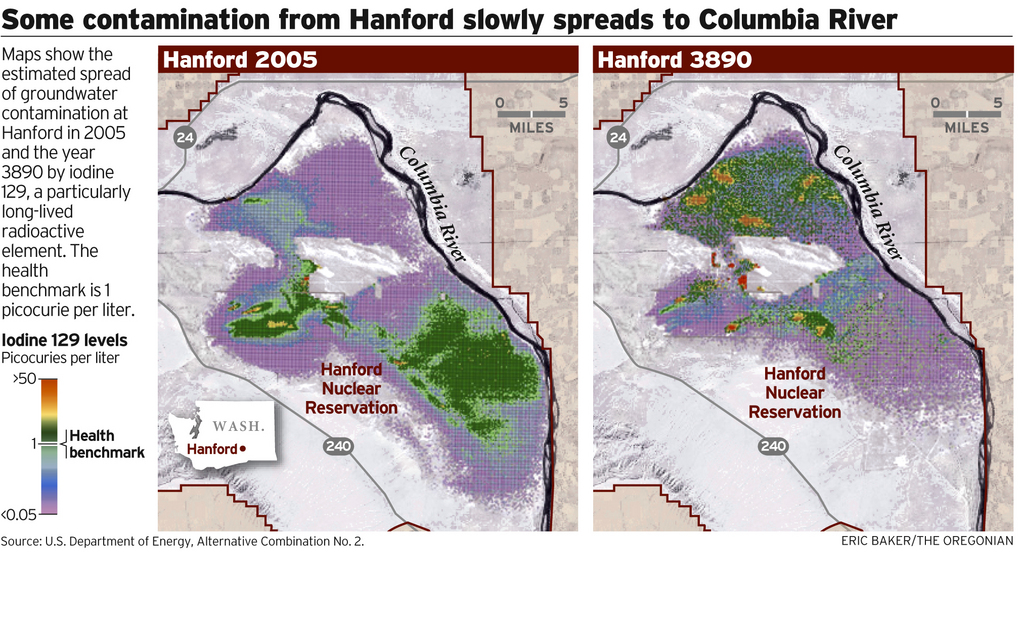forum
library
tutorial
contact

Despite Billions Spent on Cleanup, Hanford
Won't be Clean for Thousands of Years
by Scott LearnThe Oregonian, February 9, 2010
|
the film forum library tutorial contact |

|
Despite Billions Spent on Cleanup, Hanford
by Scott Learn |
 Some radioactive contaminants at the Hanford Nuclear Reservation will threaten the Columbia River for thousands of years, a new analysis projects, despite the multibillion-dollar cleanup efforts by the federal government.
Some radioactive contaminants at the Hanford Nuclear Reservation will threaten the Columbia River for thousands of years, a new analysis projects, despite the multibillion-dollar cleanup efforts by the federal government.
The U.S. Department of Energy projections come from a new analysis of how best to clean up leaking storage tanks and manage waste at Hanford, a former nuclear weapons production site on 586 square miles next to the Columbia in southeastern Washington.
"We think it should force a re-look at the long-term cleanup plan at Hanford," said Ken Niles, assistant director of the Oregon Department of Energy. "We don't want that level of contamination reaching the Columbia River."
The analysis also shows that the U.S. energy department's plan to import low-level and midlevel radioactive waste from other sites to Hanford after 2022 poses "completely unacceptable" risks, Niles said. Washington is also raising concerns about importing more waste.
The government holds a public hearing Wednesday in Portland on the draft environmental impact statement for tank closure and waste management. Public comments are open through March 19.
Health risks from Hanford's contamination are long-term, not immediate. They're expressed in terms of cancer cases after a lifetime of drinking well water from the site, with a one in 10,000 risk considered high. But many of the contaminant levels at the site exceed health benchmarks by wide margins.
 The U.S. Department of Energy report says the risks from some high-volume radioactive elements, including tritium, strontium and cesium, have already peaked and should diminish relatively quickly. For all locations at Hanford, the peak radiological risk has already occurred, the report says.
The U.S. Department of Energy report says the risks from some high-volume radioactive elements, including tritium, strontium and cesium, have already peaked and should diminish relatively quickly. For all locations at Hanford, the peak radiological risk has already occurred, the report says.
Exposure to lower-volume contaminants with long radioactive half lives, including isotopes of plutonium, iodine and technetium, is projected to get worse over time in some parts of the site as contamination -- most from the 1950s and 1960s -- migrates in groundwater, the analysis indicates.
In the report, the energy department says its preference is to remove and process 99 percent of the contamination in the tanks, excavate about 15 feet underneath them, then cap the site -- an approach that would leave much of the leaked contamination still in the environment. It also favors covering contaminated ditches at the tank farms instead of excavating them.
But Mary Beth Burandt, an Energy Department manager, said the agency is undecided and will likely propose steps to address public concerns. Such steps could include more treatment, barrier walls to block contaminant flows and limits on long-lived radioactive elements in incoming waste.
A preference "doesn't mean the department isn't going to take a look at (public feedback) and say, 'Do we need to reprioritize?'" Burandt said.
Hanford produced nuclear materials from 1944 through 1988, operated nine nuclear reactors to produce plutonium and generated millions of gallons of radioactive and hazardous waste. Some of the waste was dumped directly into ditches, some was buried in drums and some was stored in 177 huge underground tanks, including 149 leak-prone single-walled tanks.
 It's now the nation's most contaminated radioactive cleanup site.
It's now the nation's most contaminated radioactive cleanup site.
Hanford activists want more thorough cleanup of the tank farms and the site in general, saying the cleanup will leave ample contamination at the site and groundwater pollution well above Washington drinking water standards.
"This is a different story than we've been told for 20 years," said Nancy Matela, a Portland-based Hanford activist. "They're saying, we've done our best and we can do it up to this point, but after that we're going to cap it and forget about it."
But more thorough cleanup would cost almost twice as much, the analysis says, and wouldn't show different results for thousands of years. In the meantime, a more thorough cleanup would expose workers to more risk and double the use of electricity, the department says.
A U.S. Government Accountability Office report in September on tank cleanup said the total estimated cost has risen dramatically and could go as high as $100 billion, well above the current $77 billion estimate. The latest deadline for completing cleanup is 2047, though cleanup dates have been steadily pushed back.
The GAO report also questioned whether the Energy Department's cleanup strategy "is proportional to the reduction in risk that cleanup is to achieve," the report said.
Much of Hanford's radioactivity comes from strontium-90 and cesium-137, which have half-lives of roughly three decades, the GAO said, meaning much of the risk should fall relatively quickly.
Public hearingRelated Pages:
An open house and public hearing on the U.S. Department of Energy's draft environmental impact statement for cleaning up storage tanks and managing waste at the Hanford Nuclear Reservation will start at 6 p.m. Wednesday at the Portland DoubleTree Hotel at Lloyd Center, 1000 N.E. Multnomah St.Oregon officials say the results, including contamination projections for the next 10,000 years, indicate the federal government needs to clean up more of the waste that has already leaked and spilled at Hanford instead of capping and leaving it, a less-expensive alternative.
learn more on topics covered in the film
see the video
read the script
learn the songs
discussion forum
